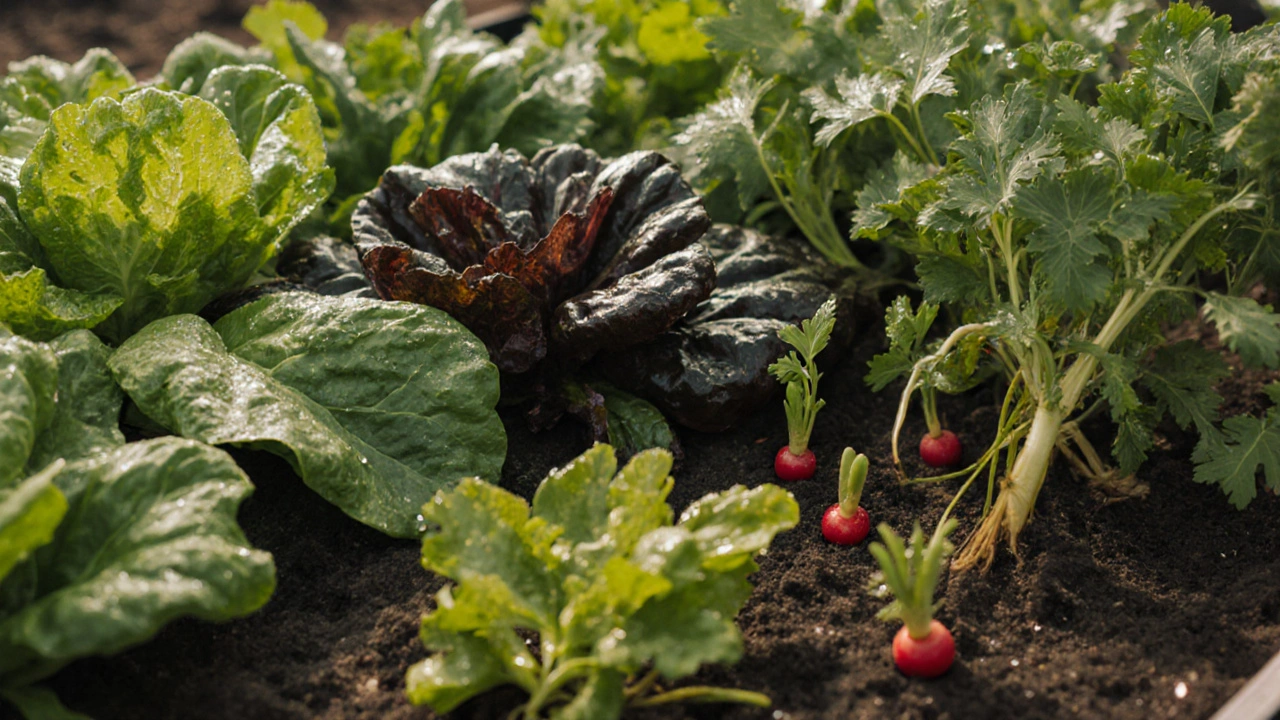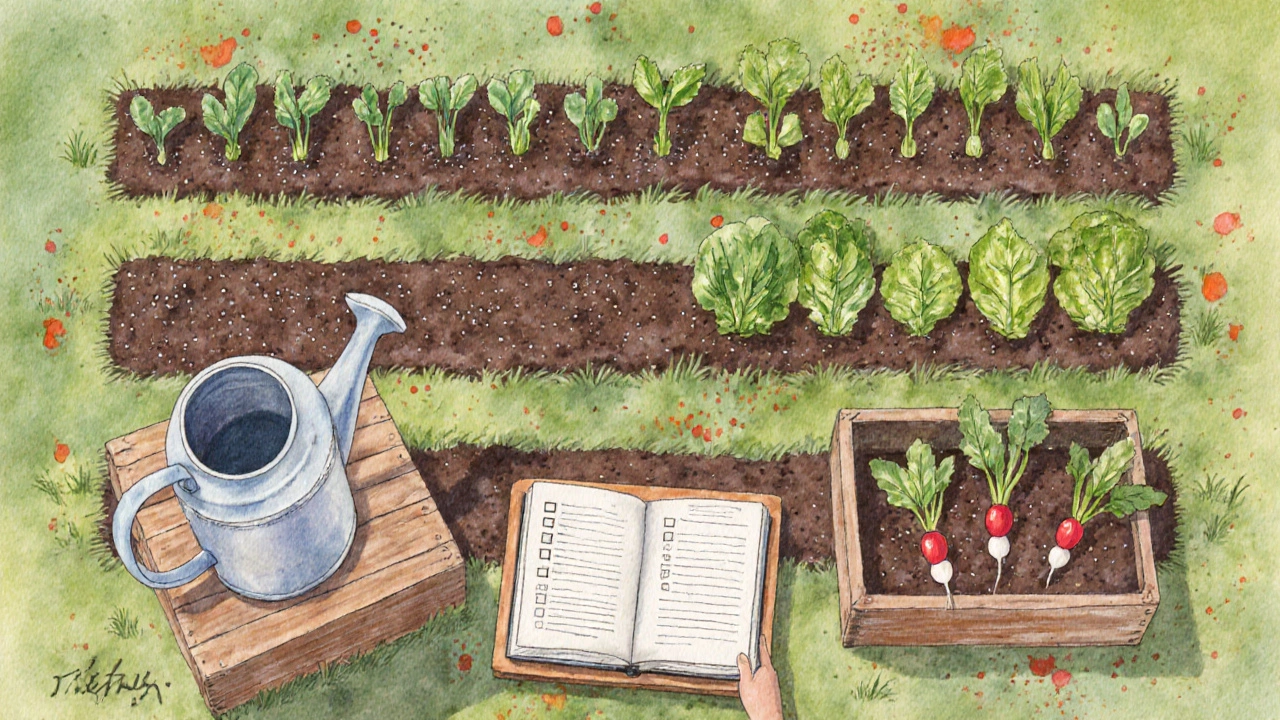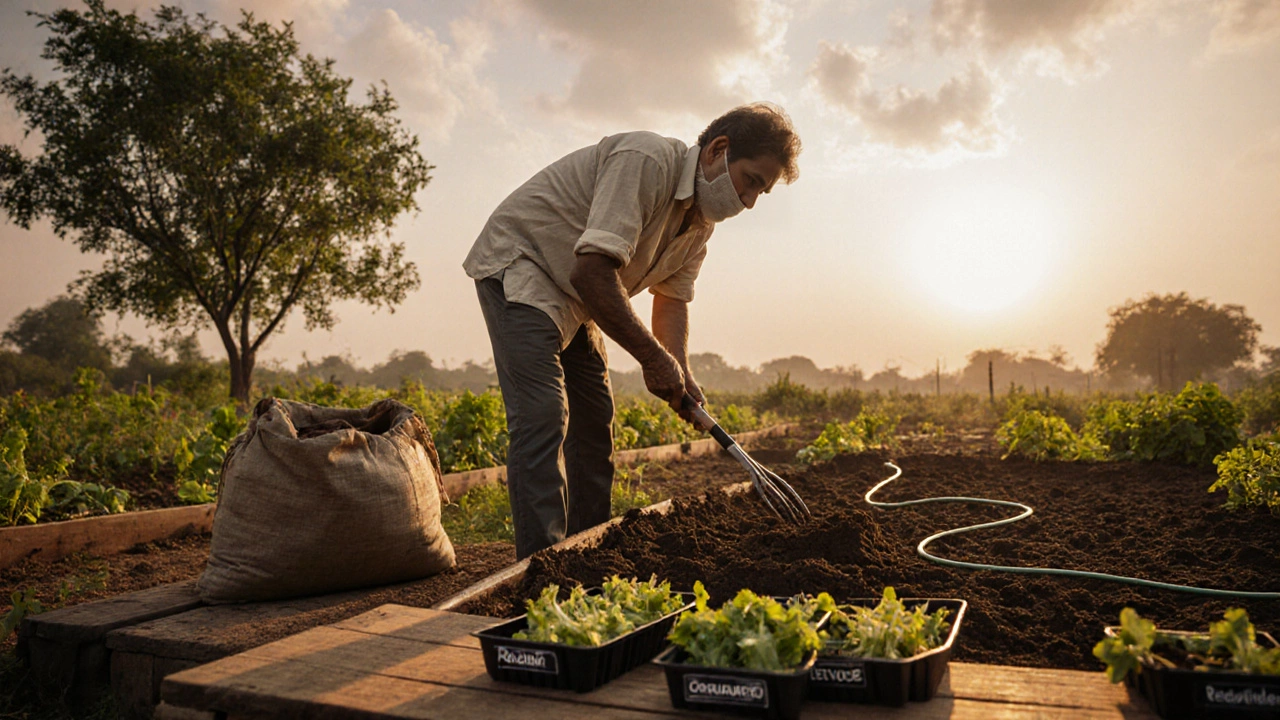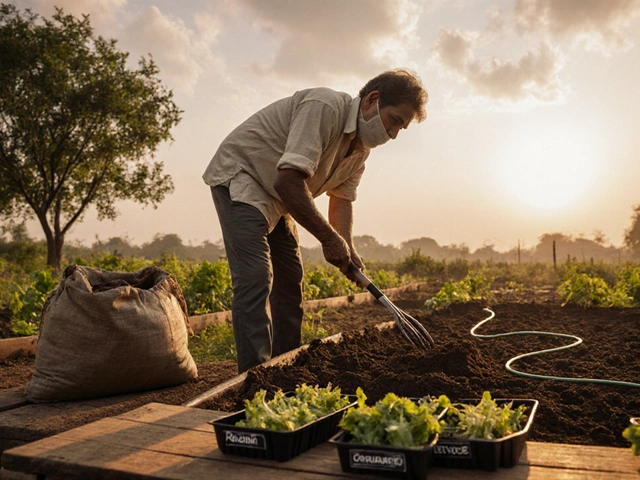Fast-Growing Plant Finder
Discover which plants will grow in 30 days for your region and season
Recommended Plants
Ready in 25-30 days
Ready in 30-35 days
Ready in 30-40 days
Ready in 30 days
Ready in 28-35 days
Ready in 30-45 days
Ready in 20-30 days
Need a fresh salad or a quick side dish before the monsoon hits? If you live in India and have only a month to spare, you’re not alone. Many gardeners ask, what plant grows in 30 days? The answer isn’t a mystery - it’s a handful of hardy, fast‑maturing crops that thrive in the right season, soil, and care routine. Below you’ll find the science behind a 30‑day growth cycle, the top seven plants that fit the bill, and a ready‑to‑use checklist so you can start harvesting in just four weeks.
Key Takeaways
- Seven crops can be ready to harvest in roughly 30days across India’s major growing zones.
- Temperature range 20‑30°C, loose loamy soil, and regular moisture are the core requirements.
- Seed‑to‑plate timelines shrink dramatically when you sow directly into warm, well‑drained beds.
- A simple planting checklist can prevent common setbacks like bolting or fungal problems.
- Use the comparison table to match the right crop with your regional climate and garden space.
Why 30 Days Works - The Science of Rapid Growth
Plants that finish their life cycle in a month belong to the fast‑growing plant category, which relies on a few biological shortcuts. They produce fewer leaves before flowering, allocate more energy to root development, and have seeds that germinate at temperatures above 20°C. In India, the post‑monsoon months (July‑September) and early winter (October‑December) provide the ideal temperature window for most of these species.
Equally important is soil texture. A loose loam with a pH between 6.0 and 7.0 lets roots expand quickly, while compost or well‑rotted farmyard manure supplies the nitrogen boost needed for rapid leaf growth. Lastly, consistent moisture -not water‑logged, not bone‑dry-keeps the metabolic processes humming. A drip emitter or a fine spray every 12hours during hot spells does the trick.
Top 7 Plants That Mature in About 30 Days
Radish (Raphanus sativus)
Radish is the classic 30‑day hero. From seed to crisp root, you’ll see harvestable size in 25‑30days. Plant in lateJuly for a September crop in the north, or October in the south where the weather stays warm. Space seeds 2cm apart, thin to 5cm after emergence, and keep the beds moist. Harvest when the roots reach 2‑5cm for the best bite.
Lettuce - Loose‑leaf Varieties (Lactuca sativa)
Loose‑leaf lettuce varieties such as ‘Buttercrunch’ or ‘Grand Rapids’ reach marketable size in 30‑35days. Sow seeds 1cm deep, keep the soil cool (15‑20°C) and water regularly. In a hot Indian summer, provide light shade in the afternoon to avoid bolting. Harvest the outer leaves once they are 10cm tall; the plant will keep producing for weeks.
Spinach (Spinacia oleracea)
Spinach varieties ‘Palak (India)’ and ‘Baby Leaf’ can be ready in 30‑40days. Sow seeds 1cm deep in a well‑drained bed with ample organic matter. Maintain a temperature of 18‑24°C and keep the soil consistently moist. Cut the outer leaves at the base; the plant will keep sending up new leaves.
Green Gram (Mung Bean) (Vigna radiata)
For a protein‑rich snack, green gram sprouts in 30days from planting to pod formation. Choose a sunny spot, sow 2‑3cm deep, and water gently. Harvest the pods when they are 5‑7cm long; the beans inside are still tender. The crop tolerates light frost, making it a good choice for November sowing in northern plains.
Coriander (Coriandrum sativum)
Coriander leaves are ready for cutting in 28‑35days. Plant in a partially shaded area to prevent bolting. Seeds germinate best at 20‑25°C; once seedlings appear, thin to 15cm spacing. Pinch off the flower stalks as soon as they appear to extend leaf production.
Mustard Greens (Brassica juncea)
Mustard greens grow quickly, reaching a harvestable size in 30‑45days. Sow 0.5cm deep, keep the soil moist, and provide full sun. Cut the leaves when they are 8‑12cm tall; the plant will regrow for multiple harvests.
Arugula (Eruca vesicaria)
Also called rocket, arugula is ready to pick in 20‑30days. It loves cool weather, so sow in October‑November for a winter harvest in most of India. Thin seedlings to 10cm and water lightly. The peppery leaves are perfect for salads and garnishes.

Quick Comparison Table
| Plant | Days to Harvest | Ideal Sowing Season (India) | Preferred Climate | Typical Use |
|---|---|---|---|---|
| Radish | 25‑30 | July‑September (North), Oct‑Dec (South) | Cool‑moderate (15‑22°C) | Salads, Pickles |
| Lettuce (Loose‑leaf) | 30‑35 | Oct‑Jan | Cool (10‑20°C) | Salads, Wraps |
| Spinach | 30‑40 | Sept‑Nov | Cool‑moderate (15‑24°C) | Leafy dishes, Saute |
| Green Gram (Mung Bean) | 30 | Oct‑Dec | Warm (20‑30°C) | Snacks, Sprouts |
| Coriander | 28‑35 | Oct‑Jan | Cool‑moderate (15‑22°C) | Herb, Garnish |
| Mustard Greens | 30‑45 | Oct‑Dec | Cool (12‑22°C) | Stir‑fry, Salads |
| Arugula | 20‑30 | Oct‑Nov | Cool (10‑18°C) | Salads, Pizza topping |
Step‑by‑Step Planting Checklist
- Soil prep: Loosen 15cm depth, mix 2kg compost per square meter, test pH (target 6.0‑7.0).
- Seed selection: Purchase certified untreated seeds; for radish and lettuce pick varieties labeled ‘early’ or ‘quick‑grow’.
- Sowing depth & spacing: Follow the specific depth in the plant list; keep rows 30cm apart for easy watering.
- Watering schedule: Light mist immediately after sowing, then 1L per square meter daily until seedlings appear; switch to 500ml every other day after establishment.
- Sunlight & shade: Provide full sun (6‑8h) for beans and radish; 4‑5h for lettuce and spinach; use a shade net during peak afternoon heat.
- Fertilizer boost: Apply a 1% nitrogen solution (e.g., urea dissolved at 10g/L) once a week for leafy crops.
- Pest watch: Spot aphids on lettuce, flea beetles on radish; use neem spray (2% solution) as soon as you see damage.
- Harvest timing: Use a ruler; pull radish at 2cm, cut lettuce outer leaves at 10cm, snip spinach leaves when 8cm tall.

Common Pitfalls and How to Avoid Them
Bolting: Happens when temperatures exceed 30°C for leafy greens. Plant early in the season, provide afternoon shade, and keep soil cool with mulch.
Seed dormancy: Some radish seeds need a brief warm soak (10minutes in 30°C water) to break dormancy, especially in cooler northern regions.
Over‑watering: Water‑logged soil suffocates roots. Use a raised bed or add coarse sand to heavy clay soils.
Pest outbreaks: Rotate crops every two seasons to break pest cycles. For example, follow a radish bed with a legume like mung bean.
Next Steps - Scaling Your 30‑Day Harvest
Now that you have a starter list, experiment with staggered sowing. Plant a new row every 5days and you’ll enjoy a continuous supply of fresh greens and radishes throughout the month. If space allows, try inter‑cropping - planting faster growers like arugula between slower beans. Keep a simple garden journal: note dates, weather, and yield. Over time you’ll fine‑tune the exact days for your micro‑climate.
Frequently Asked Questions
Can I grow these 30‑day plants in containers?
Absolutely. Choose a pot at least 15cm deep and fill it with a lightweight potting mix blended with compost. Ensure the container has drainage holes and place it on a tray for easy watering. Most of the listed crops - radish, lettuce, spinach, and coriander - perform well in 5‑liter pots.
Do I need to fertilize every 30‑day crop?
A single dose of compost at planting supplies enough nutrients for most short cycles. If you want a bigger leaf yield, a light nitrogen boost (1% solution) once a week, as described in the checklist, is enough. Over‑fertilizing can cause leaf curling.
What’s the best way to store harvested radishes?
Trim the tops, rinse gently, and store them in a perforated bag inside the refrigerator’s crisper drawer. They stay crisp for up to two weeks. For longer storage, slice and pickle within a week of harvest.
Is it safe to plant these crops during the monsoon?
Most 30‑day crops prefer a dry spell after sowing, so avoid planting right at the peak of heavy rains. If you must plant during monsoon, use raised beds with good drainage and a thin layer of mulch to keep soil from becoming soggy.
Can I grow multiple of these plants together?
Yes. Pair fast‑leafy greens (lettuce, spinach, mustard) with a root crop like radish. The leafers shade the soil, reducing moisture loss, while the radish taps deeper nutrients. Just keep spacing adequate to avoid crowding.


